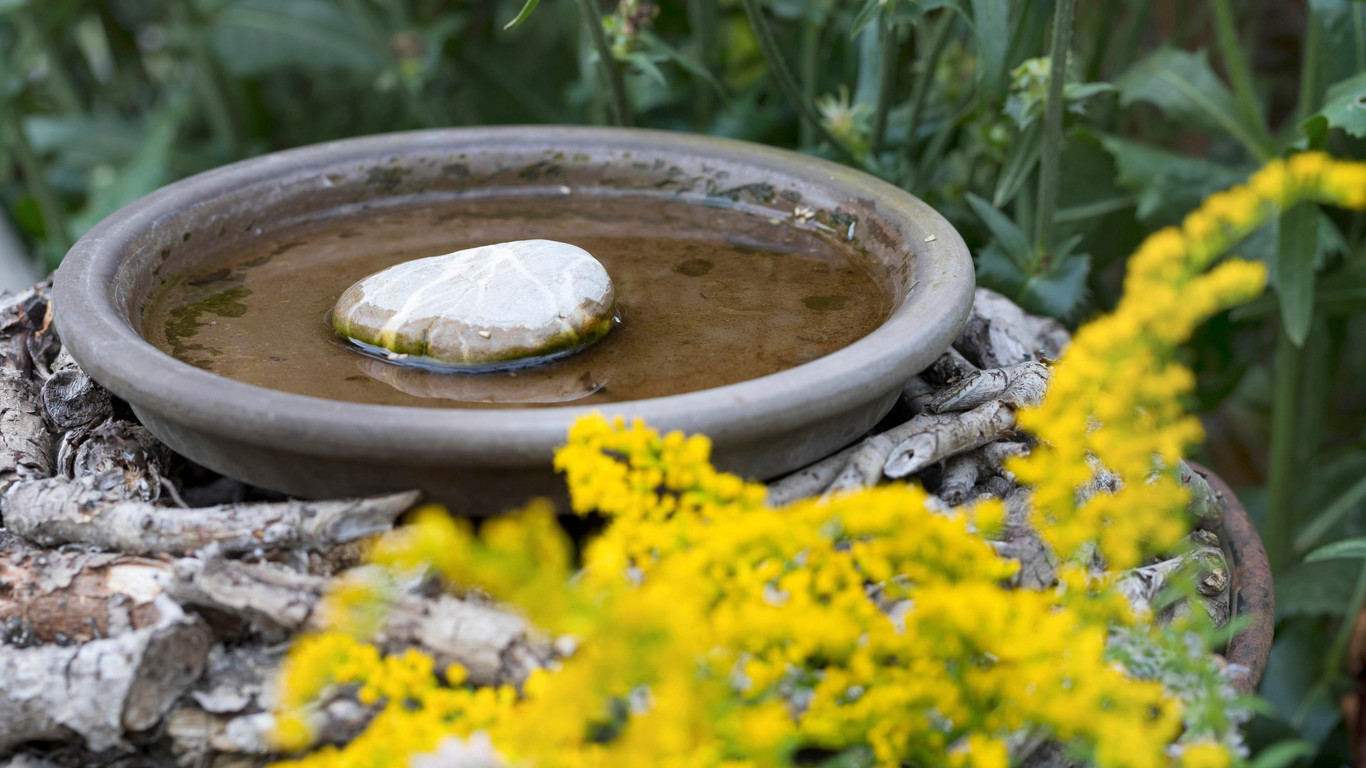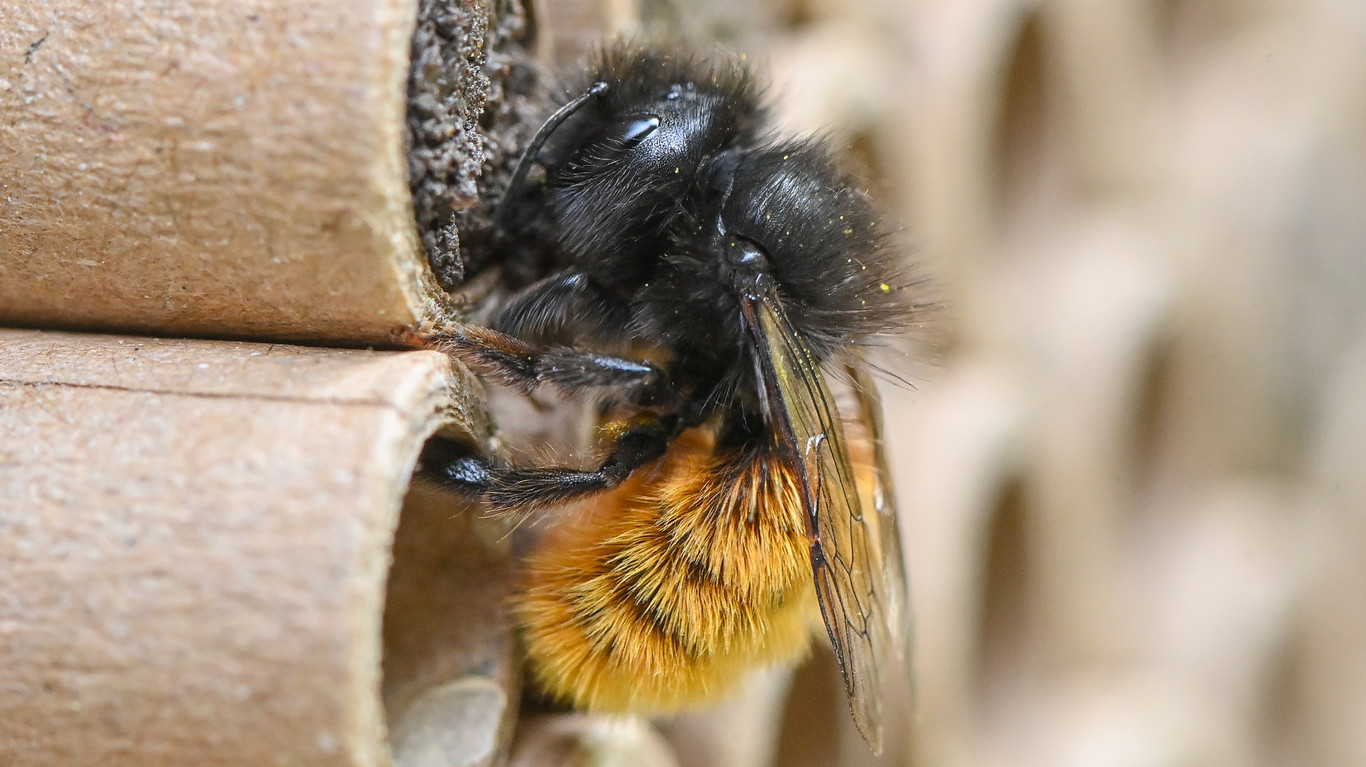Insect troughs in the garden are intended to help wild bees and butterflies survive on hot days, for example – as a substitute for natural bodies of water. What needs to be considered during construction? And are insects thirsty at all?
It’s hot, you’re sweating – and you’re constantly losing water as a result. This is just as true for humans as it is for insects. They lose water when they breathe and through their skin. To avoid dehydration, most insects need to drink or eat food containing water. Many garden owners want to help insects do this in the summer when it’s hot – and set up an insect waterer. But does that even make sense? How should an insect drinker look so that it doesn’t become an insect trap? And what exactly is thirst like for insects?
Contents
- 1 Waxes as evaporation protection
- 2 Honey bees do not usually need an insect drinker
- 3 Some insects need water to build their nests
- 4 Do bees need help?
- 5 Prefer damp moss to a large water surface
- 6 Insect drinkers should not be insect traps
- 7 Tap water or rainwater?
- 8 Insect drinkers are not disease hotspots
- 9 Author
Waxes as evaporation protection
Insects have a lot of surface area in relation to their volume and thus also a lot of evaporation surface area. To prevent these winged creatures from drying out in the blink of an eye, Mother Nature had to be inventive.
The cuticle, the outer skeleton of insects, is made up of three layers. Two of them are permeable to water vapor. Only the third, outermost and extremely thin layer of wax-like substances ensures that evaporation does not become too great. Without this protective wax layer, insects would dry out in a short time. When it is very hot or when they are very active, the animals still lose a lot of body fluid and have to compensate for these losses.
Honey bees do not usually need an insect drinker

As a rule, insects do not drink water. They extract fluid from their food or drink plant juices. Honey bees, wild bees and wasps suck flower nectar, hornets gnaw holes in the juicy bark of young branches of lilac, ash or fruit trees to get their sap. The stag beetle licks with its brush-like lower lip at the sap that emerges from cracks and wounds on the trunk of oaks or beeches.
As long as there is enough nectar and honeydew, honey bees do not need additional water. It is only during the “no-pollination” period and on hot days that the life-giving water needs to be brought in selectively. Then the water fetchers go in search of water. They fill their honey bladders with water and fly back to the hive.
There, the nurse bees process the water into food juice for the larvae. On particularly hot days, the animals additionally distribute water drop by drop in the brood nest area to protect the offspring from heat death. Many beekeepers set up bee drinkers near the hive during the breeding season.
Insects, like most organisms, require water to survive, but their water needs are often met through their natural environment. Insects obtain water through various means, and providing water for them in a garden or outdoor setting is not typically necessary. Here are some ways insects access water:
- Rain: Many insects rely on rainwater as a primary source of hydration. They are adapted to collect and store water from rainfall or dew on plant surfaces.
- Nectar and Plant Sap: Insects like bees and butterflies often get their water needs met by consuming nectar and plant sap, which are high in moisture content.
- Puddling: Some male butterflies engage in “puddling” behavior, which involves congregating around mud puddles, moist soil, or wet sand to extract minerals and water.
- Dew: Insects may access water from the dew that forms on plant leaves and other surfaces in the early morning.
- Moisture in Plants and Soil: Insects may obtain water from the moisture found within plants or from the soil.
While providing water specifically for insects is not necessary in most cases, maintaining a well-balanced garden with diverse plant species and natural water sources can help support local insect populations. Gardens with flowering plants and a variety of vegetation can provide nectar and moisture to attract and support pollinators and other beneficial insects.
However, it’s essential to avoid standing water sources, as they can become breeding grounds for mosquitoes and other pests. Ensuring a garden with a balanced ecosystem and suitable plantings is often the best way to provide insects with the water they need.
Some insects need water to build their nests
The large clay wasp needs water to build its barrel-shaped brood cells. It likes to use the morning dew on leaves and stalks as a water source. The wasp, which can grow up to two and a half centimeters in size and is extremely slender, fills its crop with water and flies to a spot with clayey soil.
There it spits the water onto the clay and forms small beads from the softened material. The beads are transported to the building site, where they spend hours gluing them together to form a nest. Mason bees also build with clay. They do not need water, however, because they only use moist building material. They collect small chunks of clay or sandy soil from streams, the edges of puddles or damp ground.

Do bees need help?
State-building bees and wasps use water primarily to cool their burrows, honeybees also for rearing larvae. Clay wasps take in water to build brood cells. As a rule, the water offered by nature is sufficient for the animals: dew drops, the condensation water of plants or damp stream and pond edges. Wasp colonies like to make use of cooling water from artificial sources when it is very hot.
Honey bees also use watering holes provided by humans, but are supplied with water by their owners when needed. Wild bees do not drink water, but only flower nectar. If the nectar-giving plants are missing, the small insects starve to death – no insect watering hole will help. Butterflies and beetles also lack food plants.
The biologist and wild bee specialist Paul Westrich is convinced that insect drinkers do not contribute to species conservation. It would be much more important to have gardens that are rich in flowers and structures. Nevertheless, such a drinking trough can be helpful for one species or another. And above all: insect drinkers – properly installed – do no harm, are pretty to look at and certainly a wonderful way to observe insects.
Prefer damp moss to a large water surface
Many insect species have a proboscis. Nevertheless, liquid is often licked up rather than sucked up. The bee’s tongue is hairy, and water sticks to the hairs in the form of tiny molecules. Therefore, a very thin film of water is sufficient for bees to drink. It doesn’t have to be penetratingly wet either, moisture is quite enough. If they have a choice, honey bees prefer to lick damp moss, sand or mud rather than fly to a free water surface. After all, a water surface always carries the risk of falling in and drowning.
Insect drinkers should not be insect traps
To avoid becoming an insect trap, an insect feeder must provide safe landing areas and shallow access to the water. A flower saucer with wet moss is ideal and perfectly adequate. The fully soaked moss can be flown or crawled on without danger. Wet soil also provides welcome moisture to wild bees and butterflies.
However, such soil and moss trays have the disadvantage that they dry out quickly. A tray filled with water requires much less maintenance. To ensure that the animals can land safely, stones should be placed in the bowl so that at least half of the stones protrude from the water. A strip of moss around the edge provides safe access for flightless or sluggish visitors. If you like, you can decorate the whole thing with colored glass marbles or other pretty things.
Tap water or rainwater?
Tap water is unpopular with honey bees, rainwater has the disadvantage that it quickly turns green and becomes algae. With the addition of a little lime, rainwater stays fresh longer. If you want to attract honey bees specifically, a drop of anise oil in the water is helpful.
Sometimes sugar or honey water is recommended – but it is not advisable, because at such a sweet watering place the honey bees start biting and stinging. The animals fight for the sweet water and kill each other. However, a pinch of salt in the water might be worth a try. Some beekeepers report that their bees prefer salty water.
Insect drinkers are not disease hotspots
Wild bee specialist Paul Westrich believes it is unlikely that insect-specific diseases will spread at an insect drinker. Research has shown that contagions primarily occur during flower visits. Nevertheless, it doesn’t hurt to change the water once a week. Otherwise, the insect watering place could quickly mutate into a mosquito breeding ground.
Finally, about the place of installation: the best would be a windless place with morning sun. This way the water warms up quickly, the animals do not cool down, remain active and can be observed wonderfully.

